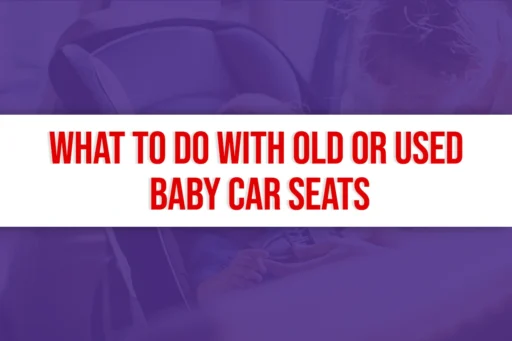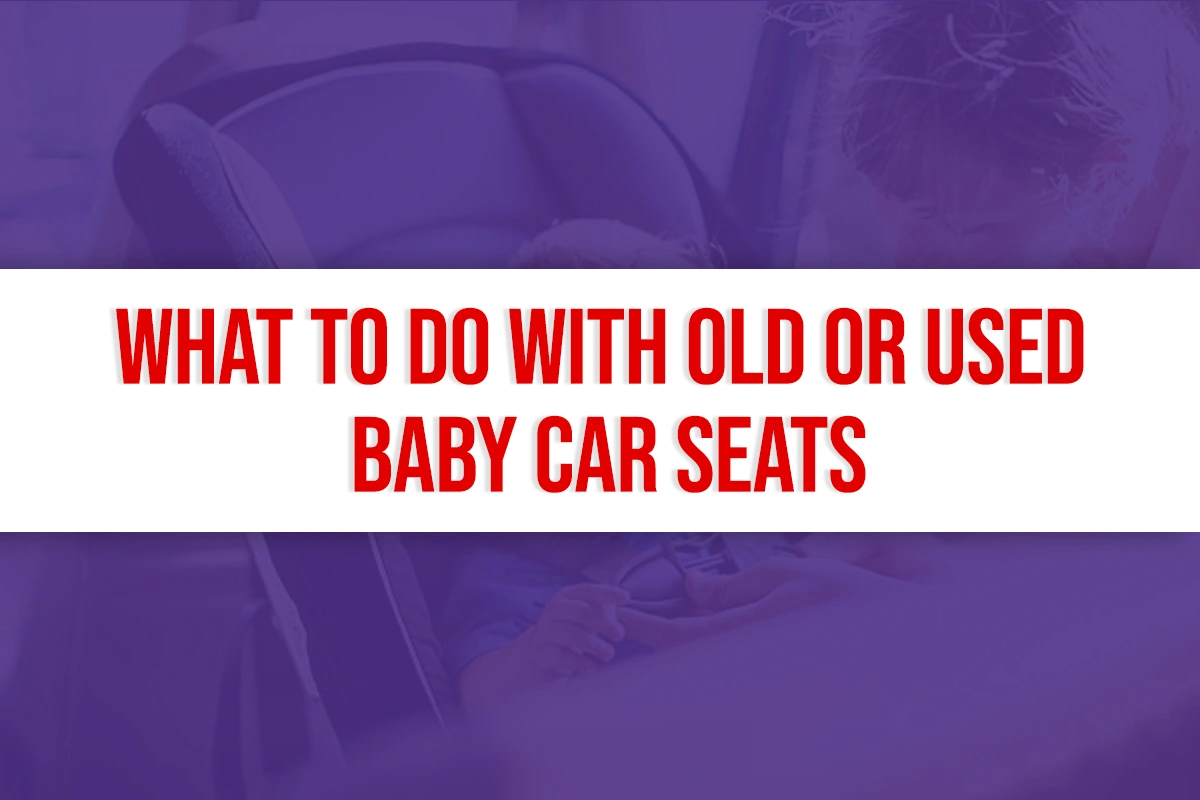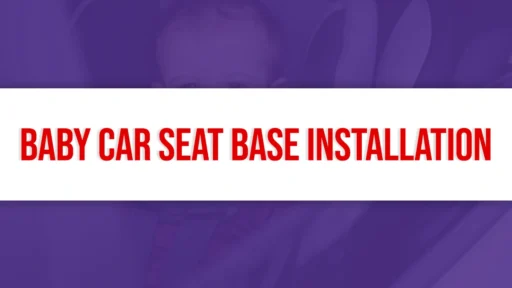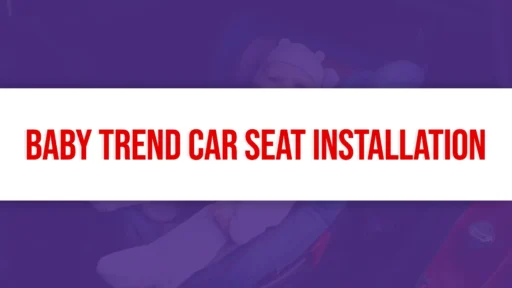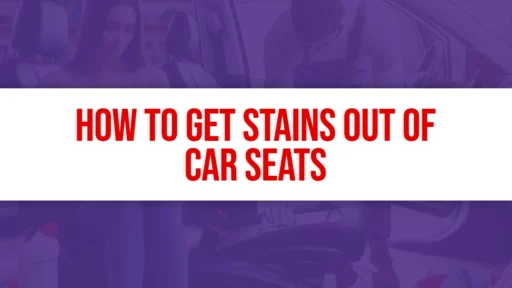Baby car seats are essential for child safety. But, what happens when they outgrow them?
Many parents face this dilemma. Old or used baby car seats often pile up, unused and taking up space. Disposing of them isn’t straightforward due to safety and environmental concerns. This blog will explore practical and responsible ways to handle old baby car seats.
We’ll look at recycling options, donation possibilities, and creative repurposing ideas. Discover how to give these seats a second life, benefiting both your home and the environment. Join us as we navigate the best options for your used baby car seats, ensuring they don’t end up in a landfill. Let’s make your space safer and greener.
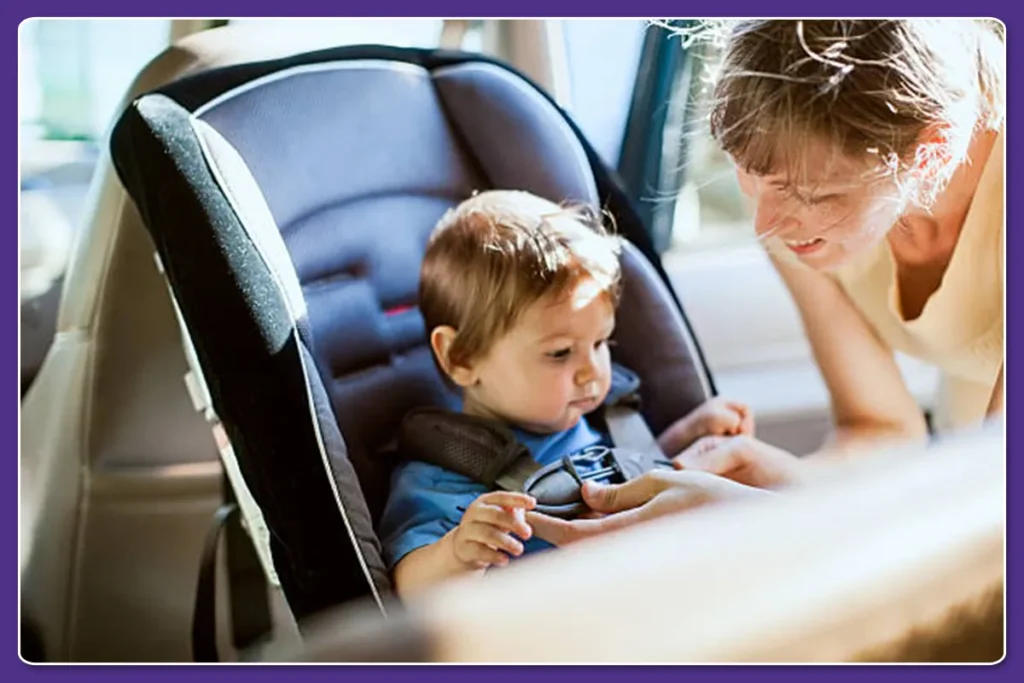
Safety Concerns
Ensuring the safety of your child is the most important thing. Especially in cars. Old or used baby car seats might not meet current safety standards. This can pose serious risks. Below, explore some important safety concerns.
Expired Car Seats
Car seats have an expiration date. This is typically six to ten years from the manufacture date. Materials degrade over time. Plastic and metal parts can weaken. This reduces the seat’s ability to protect your child in a crash. Always check the expiration date. You can find it on the label or the manufacturer’s website.
Damaged Car Seats
Inspect used car seats for damage. Look for cracks, fraying straps, or missing parts. Even minor damage can compromise safety. A car seat involved in a crash should never be reused. It may have hidden damage. This can make it less effective in protecting your child. Ensure all parts are intact and functioning.
Recycling Options
Are you wondering what to do with your old or used baby car seats? Recycling is a responsible and eco-friendly option. Let’s explore the different ways you can recycle your car seat and contribute to a greener planet.
Recycling Programs
Many communities offer recycling programs specifically for baby car seats. These programs ensure that the materials are properly disposed of and reused. Check with your local recycling center to see if they accept baby car seats.
- Some centers have specific drop-off days.
- Others may require you to dismantle the car seat first.
Make sure to follow any guidelines provided by the recycling center. This helps ensure that the seat is processed correctly.
Manufacturer Take-backs
Several car seat manufacturers have take-back programs. These programs allow you to send the used car seat back to the manufacturer.
Here is a list of some manufacturers that offer take-back programs:
| Manufacturer | Program Details |
|---|---|
| Graco | Offers recycling events and take-back options. |
| Britax | Provides a trade-in program for used car seats. |
| Target | Hosts car seat trade-in events annually. |
Participating in these programs is straightforward:
- Visit the manufacturer’s website.
- Find information on their take-back program.
- Follow the steps to send in your car seat.
These programs ensure that the car seat is properly recycled or reused.
Donation Opportunities
If you have an old or used baby car seat, consider donating it. Donation opportunities are abundant and can make a big difference for families in need. By donating, you ensure the car seat gets a second life and helps someone else.
Charity Organizations
Many charity organizations accept used baby car seats. They provide these to families who cannot afford new ones. Look for local charities that focus on children’s safety and well-being.
- Salvation Army
- Goodwill
- Safe Kids Worldwide
Before donating, check the car seat’s condition. It should not be expired or damaged. Some charities have specific guidelines, so always contact them first.
Community Centers
Local community centers can be a great place to donate. They often run programs to support low-income families. Your donation can help ensure a child’s safety on the road.
Visit your nearest community center and inquire about their donation policies. Many centers have partnerships with local groups that distribute baby items.
Some community centers also host events where families can pick up needed items. Donating your old car seat can be a part of this community effort.
Repurposing Ideas
Old or used baby car seats can find new life with a bit of creativity. Repurposing these seats helps reduce waste and adds a unique touch to your home. Here are some practical and fun ideas to give old baby car seats a second chance.
Home Decor
A baby car seat can be transformed into a unique piece of home decor. You can turn the seat into a cozy chair for your child’s room. Simply remove the harness, add a cushion, and you have a comfy new seat. This chair can be perfect for reading or relaxing.
Another idea is to use the car seat as a quirky plant holder. Remove the cover and fill the seat with soil. Plant some flowers or succulents. The car seat can then be placed on your porch or in your garden, adding a whimsical touch to your outdoor space.
Toy Storage
Repurpose an old baby car seat into a convenient toy storage solution. Remove the harness and cover, then use the seat to hold toys. This can be especially useful for smaller toys like action figures or dolls.
You can also attach the car seat to a wall in your child’s room. It becomes a hanging toy organizer. This keeps the floor clear and makes toys easy to reach. It’s a practical and fun way to keep the room tidy.
Old car seats can even be turned into a toy car for your child. Attach some wheels to the base and add a steering wheel. Your child will love their new ride, and it keeps the old seat out of the landfill.
Selling Used Car Seats
Getting rid of an old or used baby car seat can be tough. Many parents wonder what to do with these seats. One great option is to sell them. This can help other families and put some money back in your pocket. Let’s explore some of the best ways to sell used car seats.
Online Marketplaces
Online marketplaces are a popular choice for selling used car seats. Websites like eBay, Craigslist, and Facebook Marketplace are great options. These platforms allow you to reach a wide audience. Here’s how to get started:
- Create an account on the chosen platform
- Take clear photos of the car seat from different angles
- Write an honest description including the brand, model, and condition
- Set a fair price based on the seat’s age and condition
Be sure to include key details. Mention if the seat has been involved in any accidents. Buyers want to know this. Also, check the expiration date on the car seat. Many car seats have a limited lifespan.
Local Consignment Shops
Local consignment shops are another good option. These shops sell used items on your behalf. They usually take a small fee or a percentage of the sale price. Here’s how to proceed:
- Find consignment shops in your area
- Call to check if they accept used baby car seats
- Visit the shop with your car seat
- Discuss the terms and conditions of the sale
Consignment shops often have loyal customers. This increases the chances of your car seat selling quickly. Plus, these shops handle the selling process for you. This can save time and effort.
Swapping With Other Parents
Swapping old or used baby car seats with other parents is a great idea. This practice benefits both parties. It helps reduce waste and saves money. Let’s explore some ways to swap baby car seats effectively.
Parenting Groups
Parenting groups are excellent places to swap baby gear. These groups often have members with kids of all ages. You can find parents who need a car seat or have one to give away.
Here are some types of parenting groups to consider:
- Local community groups
- Daycare parent groups
- Church or religious groups
Local community groups often have organized swap events. Daycare parent groups are helpful as parents already trust each other. Church or religious groups might have bulletin boards for swaps.
Social Media Platforms
Social media platforms make it easy to connect with other parents. You can use various tools to find a match for your old car seat.
Consider using these platforms:
- Facebook Marketplace
- Local Buy/Sell/Trade groups
- Nextdoor
Facebook Marketplace has a wide reach and easy search options. Local Buy/Sell/Trade groups are ideal for community-based swaps. Nextdoor connects you with neighbors, making it easy to arrange pickups.
Remember to provide clear details about your car seat. Mention its condition, age, and any accessories included. Use photos to attract more interest. Always follow safety guidelines when sharing or receiving baby gear.
Creative Arts And Crafts
Old or used baby car seats don’t have to sit in storage forever. You can turn them into something beautiful and useful. Get creative with arts and crafts!
Diy Projects
Transform old baby car seats into unique DIY projects. You can create pet beds by removing the seat cover and adding a soft cushion. Pets will love their new cozy spot. Another idea is to turn the car seat into a garden planter. Just ensure there are drainage holes. Paint it with vibrant colors to brighten your garden.
For kids, convert the car seat into a toy storage bin. Remove the straps and add a fabric lining. Your kids can store their favorite toys here. These DIY projects are fun and can save money.
Art Installations
Old baby car seats can become stunning art installations. Use parts of the car seat to create sculptures. For example, use the seat frame as a base. Add other recycled materials to build your artwork. This not only recycles the car seat but also inspires creativity.
Another idea is to create a themed art piece. Paint the car seat with beautiful designs. Attach it to a wall or display it in a garden. It becomes a conversation starter and adds a unique touch to your space. Recycled art installations show that you care about the environment. They also display your artistic talents.
Educational Uses
Repurpose old or used baby car seats for educational uses. Donate them to schools for safety lessons or car seat training.
Old or used baby car seats can serve many purposes beyond their original use. One of the most impactful ways to repurpose them is for educational uses. Educators and trainers can leverage these seats to teach important lessons. They can provide hands-on learning experiences.
School Demonstrations
Old baby car seats make great tools for school demonstrations. Teachers can use them to explain the importance of car seat safety. Students can see firsthand how car seats protect young passengers. These demonstrations can be part of science or health classes. They offer real-world applications of classroom concepts. Students can also practice installing the seats. This hands-on activity helps them understand the mechanics of car safety. It also prepares them for real-life situations. This type of learning is engaging. It keeps students interested.
Safety Training
Safety training sessions benefit greatly from old baby car seats. Firefighters, police officers, and healthcare workers often need to know how to install and check car seats. Using actual seats for training makes the lessons more practical. Trainers can demonstrate the proper installation techniques. They can show common mistakes and how to avoid them. This practical knowledge is crucial for ensuring child safety. Participants can practice with the seats. This practice helps build confidence and skill. It ensures they are prepared for real-world scenarios. Reusing old car seats in this way is both educational and practical.
Frequently Asked Questions
Expired baby car seats should not be used. You can recycle or dispose of them properly. Contact local recycling centers for guidance on safe disposal.
Many organizations do not accept used baby car seats due to safety concerns. It’s best to check local guidelines or donate to a friend in need.
To recycle old baby car seats, contact local recycling centers. Some areas have specialized programs for recycling car seats, ensuring safe disposal.
Selling used baby car seats is tricky due to safety regulations. Ensure the seat meets current safety standards and is not expired before considering resale.
Conclusion
Finding new uses for old baby car seats can be rewarding. Donate them to local charities. Repurpose them for pet beds or storage solutions. Recycle parts whenever possible. Ensure safety by checking regulations. Share ideas with friends and family. Together, we can reduce waste and help others.
Make thoughtful choices for old baby car seats. This benefits the environment and the community. Thanks for reading and taking action!


